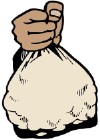In the Mystery Bag activity, students take samples from four different bags and use those samples to predict the contents of the whole bag. Students will tally the results of the samples, compare samples and match the samples to descriptions of the four bags. Finally, small groups will report sample results to the whole class so that the class is able to review the results of this larger sample and decide if their predictions still hold.
Sampling is used in polls, advertising, TV ratings, etc. In this activity students will see firsthand how the size of the sample affects the accuracy. Individual groups may pull skewed samples, but when the class data is combined, these larger samples should more accurately reflect the actual contents. NOTE: Be sure that students understand that they are sampling with replacement, meaning that they pull a tile, record the outcome, then replace the tile in the bag before pulling the next tile.
Download all materials and instructions for the Mystery Bag activity from Mathwire.



I LOVE these lessons. When I do this with kids (and teachers!) they are consistently intrigued and challenged by the idea of using a sample to determine the contents.
ReplyDeleteIf you want a special bag to go with them, here are directions:
http://love2learn2day.blogspot.com/2010/10/make-your-own-probability-pouch.html
:)
Thanks for the tutorial on sewing a probability bag. For non-sewers, brown paper lunch bags work well OR you can get fancy with some of the velvet bags found in the gift section of craft or hobby stores.
ReplyDelete